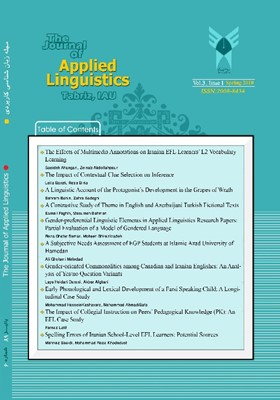شرح زبانشناختی تحول قهرمان خوشه های خشم
Subject Areas : آموزش زبان انگلیسی
1 - English Department, Shahid Madani University
Of Azarbaijan
2 - English Department, Shahid Madani University
Of Azarbaijan
Keywords: گفتمان, رمان, شخصیت پردازی, تحلیل زبانشناختی, زبانشناسی نقشگرا, تدریس زبان از طریق ادبیات,
Abstract :
رمان به عنوان ژانر ادبی مدرن معمولاً تجلی سیر شخصیت اصلی اثر از نابالغی به بلوغ تلقی می شود. شخصیت اصلی رمان که در ابتدا فرد ساده ای است که در مقابله با پیچیدگی های زندگی ناتوان است به تدریج فهم و ادراک حاصل می کند تا متعاقباً به شکلی درخور عمل کند. عموماً در نقد ادبی و نقد زبانشناختی ادبیات اتفاق نظر وجود دارد که شناخت شخصیت می بایست با توجه به عناصر متن رمان صورت گیرد (برای مثال ر.ک. فاولر 1977 و 1996، پک و کویل 2002). در این مقاله، زبان تام جود یعنی شخصیت اصلی رمان خوشه های خشم جان استاین بک تجزیه و تحلیل می شود تا روشن شود که چگونه وی از یک کارگر مزرعه ی سهل انگار جوان به مصلح اجتماعی آینده نگر بدل می شود. به دلیل رویکرد زبانشناختی به مطالعه ی ادبیات در این مقاله، زبانشناسی نقشگرای هلیدی چارچوب تحلیل بوده است. نتایج حاصل از این مطالعه می تواند در تدریس زبان انگلیسی از طریق ادبیات مفید باشد.
Alexander, C. (1965) John Steinbeck’s The Grapes of Wrath. New York: Prentice Hall.
Barnett, M. A. (1991) Language and literature. ADFL Bulletin 22 (3), 7–11.
Doyle, B. (1989) English and Englishness. London: Routledge.
Eaglestone, T. (2000) Doing English. A Guide for Literature Students (2nded.). London and New York: Routledge.
Eggins, S. (1994). An Introduction to Functional Grammar. London: Pinter Publishers.
Fontenrose, J. (1963). John Steinbeck, An Introduction and Interpretation. New York: Holt, Rinehart, Winston, Inc.
Fowler, R. (1977) Linguistics& the Novel. London: Routledge.
Fowler, R. (1996) Linguistic Criticism. Oxford: Oxford University Press.
Hall, G. (2005). Literature in Language Education. New York: Palgrave MacMillan.
Halliday, M. A. K. (1971) ‘Linguistic Function and Literary Style’ in J. Webster (Ed.) (2002) Linguistic Studies of Text and Discourse (pp. 88-122). London and New York: Continuum.
Halliday, M. A. K. (1978) Language as Social Semiotics. London: Edward Arnold.
Halliday, M. A. K. (1988)An Introduction to Functional Grammar. London: Edward Arnold.
Kramsch, C., &Kramsch, O. (2000). The avatars of literature in language study. Modern Language Journal,84, 553–73.
Leech, G., & Short, M. (1981) Style in Fiction: A Linguistic Introduction to English Fictional Prose. London and New York: Longman Group Limited.
MacCabe, C. (1987) The state of the subject (I). Critical Quarterly,29, 5–8.
MacRae, J. (1991).Literature with a Small ‘l’. London: Macmillan.
Palmer, D. J. (1965).The Rise of English Studies: An Account of the Study of English Language and Literature from its Origins to the Making of the Oxford English School. Oxford: Oxford University Press
Peck, J.,& Coyle, M. (2002) Literary Terms and Criticism. New York: Palgrave Macmillan.
Steinbeck, J. (1946) The Grapes of Wrath. New York: Bantam Books
Thompson, G. (2004). Introducing Functional Grammar. London: Arnold.
Todorov, T. (1990) Genres in Discourse. Trans. C. Porter. Cambridge: Cambridge University Press
Widdowson, H.G. (1975) Stylistics and the Teaching of Literature. Essex: Longman.


